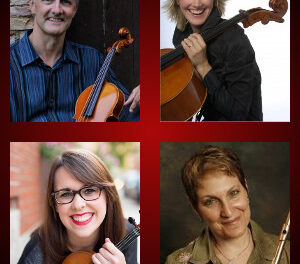When the long-time music director of the Greensboro Symphony, Peter Paul Fuchs, and his wife, Elissa, settled into the cultural life of the city decades ago, they were told “Greensboro doesn’t do chamber music.” Current GSO music director Dmitry Sitkovetsky is determined to change that climate, and it has been gratifying to witness the steady expansion of attendance since his first Sitkovetsky and Friends series concert in 2004. Each concert has a work by the composer around whom Sitkovetsky has chosen to build his orchestral and chamber music programs. Last year it was Beethoven; this year it is Brahms. The concerts feature the orchestral series’ guest soloists, Sitkovetsky, and players selected from the orchestra’s roster. There were very few empty seats in UNC Greensboro’s fine Recital Hall for a program emphasizing contrasting instead of complementing composers.
Brahms’ burnished and glowing Quintet in B Minor for Clarinet and Strings, Op. 115, is a late work that was inspired by the marvelous proficiency of the clarinetist Richard Mühlfeld, whom Brahms heard in the spring of 1891. The composition of a clarinet trio was followed quickly by a quintet. According to Melvin Berger, in Guide to Chamber Music, “‘the quintet is unsurpassed in displaying the clarinet’s most telling effects – its clear high soprano voice in the clarion register, the hollow, breathy mystery of its middle tones, and the dark, romantic cast of its low, chalumeau range.” The first theme of the opening movement is “insinuated” by the two violins, and after a transition built around staccato notes, the clarinet plays a second theme derived from part of the first theme. Brahms gives this a tightly argued development using traditional sonata form. The heart of this autumnal quintet, filled with the composer’s characteristic bittersweet melancholy, is the slow movement. Berger aptly calls the theme, sung by the clarinet, “a love song, serene and dreamlike in character.” The slow pace of this second movement is interrupted in the middle by “a wild, Hungarian-style improvisation for the clarinet” set against “a cimbalom-like accompaniment by pizzicato strings.” The third movement, marked Andantino, features development fragments derived from the opening theme of the work. Brahms’ supreme mastery of the art of variation is manifest in the theme and five variations of the finale. The theme is seamlessly spun out by the first violin and clarinet and is related to both the theme of the third movement and the opening first movement theme.
GSO principal clarinetist Kelly Burke was joined by Sitkovetsky and associate concertmaster Fabrice Dharamraj, violins, assistant principal violist Maureen Michels, and cellist Marcia Riley. They conjured up a glowing, mellow sound that captured the late Brahms mood of wistful reflection. Burke’s control, refined phrasing, and tonal palette were breathtaking. The string players blended and matched each other’s phrasing and timbre closely yet were able to give vivid individual contributions throughout the wonderful concluding set of variations.
Sergei Prokofiev (1891-1953) held little esteem for the music of Brahms. Few things could be further from the plush and structured world of Brahms than Prokofiev’s rare and unusual Sonata for Two Violins, Op. 46. According to Melvin Berger’s Guide to Sonatas, this work was inspired by Prokofiev’s experience of listening to a composition contest in Paris in the spring of 1922. Hearing so many bad compositions made him want to write a piece that would show how it should be done. The duo sonata was written in the autumn of 1932. A short and pensive slow movement opens the work and is followed by an assertive movement that has the composer’s more characteristic tart string sound. A lyrical dance-like third movement features a melody reminiscent of the composer’s much later music for the ballet Romeo i Dzhuletta. Wiry rhythmic articulation, stamping chords, and discordant decorations are just a few of the features of the vivid last movement.
What a treat it was to hear Prokofiev’s too-seldom-heard Sonata for Two Violins, Op. 56, played by two world-class soloists, Dmitry Sitkovetsky and current guest concerto soloist, the lovely virtuoso Leila Josefowicz! Their intonation was excellent as they soared to some of the composer’s stratospheric high notes. Both fielded a kaleidoscopic array of tone colors, and both were masters of the work’s rhythmic complexity. Bravo! Avid audience response was rewarded with an encore of the slow movement.












